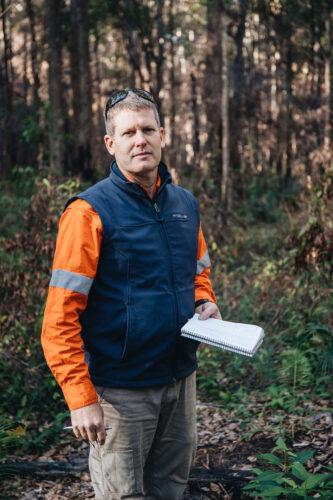Dr Geoff Pegg
Senior Principal Forest Pathology, Team Leader, Agri-Science Queensland, Department of Agriculture & Fisheries
See Dr Pegg’s full research profile here.
E: geoff.pegg@daf.qld.gov.au
Research outputs linked to policy change and decision-making
- 2022-2024: Developing partnerships to protect country from forest biosecurity threats. Exotic pests threaten cultural and environmental biodiversity values unique to Australia. The recent detection and subsequent spread of the invasive myrtle rust pathogen, Austropuccinia psidii, has highlighted the challenges associated with managing these exotic pests and pathogens. The spread of exotic environmental pests is accelerating globally, representing a significant and growing threat to Australia’s cultural heritage and biodiversity. This project is working with the Australian Chief Environmental Biosecurity Office. It is focused on collaboratively developing an environmental biosecurity training program aimed at improving the capacity of Indigenous Rangers, Natural Resource Management agencies (NRM) and other land managers across Australia to prepare for, detect and respond to plant pests and diseases threatening Australia’s forests. The project is raising awareness of environmental biosecurity and increasing engagement with and between Indigenous groups and other land managers. It is also increasing our capacity to detect and report on biosecurity threats to Australia’s unique environments through the development of surveillance plans, enhancing preparedness for incursions.
The project is in the process of developing a business model to:
- Enhance the capacity of Indigenous Rangers to identify and respond to pest and pathogen threats to culture and Country.
- Increase the capacity for communities to independently manage the health of Country.
- Capture the cultural values of plant species and ecosystems to assist in the development of pest and disease surveillance activities and management.
- Capture, where appropriate, the cultural values of plant species and ecosystems to better inform risk assessment under National Biosecurity Planning programs and to better inform the public.
Managing myrtle rust and its impacts in Australia – Plant Biosecurity CRC
Austropuccinia psidii, commonly known as myrtle rust, has long been considered a significant threat to Australian ecosystems. In April 2010, A. psidii was detected for the first time in Australia on the central coast of New South Wales. The impact it would have on plant industries reliant on Myrtaceae and native species was unknown. This project formed the foundation of research looking into the susceptibility of Myrtaceae to A. psidii and impact of myrtle rust on species across their natural range and the associated ecosystem. We identified significant impacts caused by A. psidii on threatened species with restricted natural ranges as well as those with a broad native range and considered widespread. Impacts on keystone species such as Melaleuca quinquenervia were also identified, including tree death, decline in tree vigour, and reduced fecundity. Using glasshouse screening methods developed in this project, we were able to study populations of M. quinquenervia and other broad-leaved Melaleuca spp. providing a better understanding of resistance patterns as well as identifying populations at greatest risk of significant impact. Outcomes from this study resulted in the listing of Rhodomyrtus psidioides and Rhodamnia rubescens as Critically Endangered species under initially the NSW Conservation act and then more recently the Environment Protection and Biodiversity Conservation Act 1999 (EPBC Act). Additional species are now under consideration for listing. This study also provided the baseline information for the development of the Myrtle Rust National Action Plan.
Current employment and positions
- 2000–present: Senior Principal Forest Pathologist, Team Leader Forest Production & Protection, Department of Agriculture & Fisheries Queensland.
Highest qualification
- 2011: PhD in Forest Pathology, The University of Queensland.
Major prizes, medals and honours
- 2011: Dean’s Award for Research Higher Degree Excellence (UQ) for my PhD thesis “The biology, epidemiology and variability of Quambalaria shoot blight of Corymbia species”.
- 2016: Biosecurity Impact Award, Plant Biosecurity CRC for Myrtle rust research “Understanding myrtle rust epidemiology and host specificity to determine disease impact in Australia”
- 2018: Chairman’s Award, Plant Biosecurity CRC for Myrtle rust research “Managing myrtle rust and its impacts in Australia”
- 2019: New Zealand Biosecurity Bio-Protection Research Centre Science Award “Ngā taonga – Safeguarding the mauri of myrtles and dependent ecosystems”
- 2020: Australian Environmental Biosecurity Award – This prestigious award recognised my significant contribution to Australia’s environmental biosecurity through my research and leadership in managing environmental disease incursions and sharing my knowledge with Indigenous Rangers and Land Managers, working in partnership to develop and deliver projects addressing the threats exotic forest pests and disease pose to the cultural and environmental biodiversity values unique to Australia.
Roles on government or regional organisation committees
- National Forest Health and Biosecurity Subcommittee, Technical Expert
- Australian Tea Tree Industry Biosecurity reference panel, Technical Expert
- New Zealand Myrtle rust and Kauri dieback – Strategic Science Advisory Groups – Technical Expert
- Western Australia Myrtle rust working group – Technical Expert
- National Myrtle Rust Working Group
